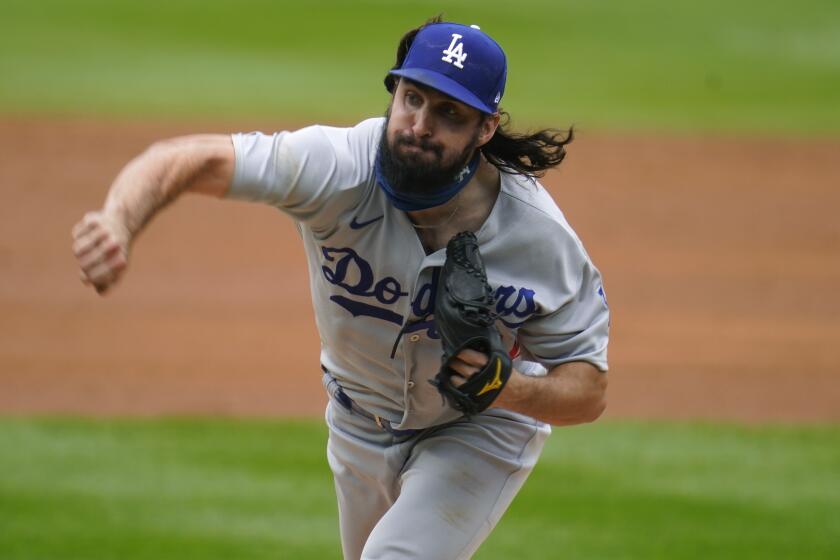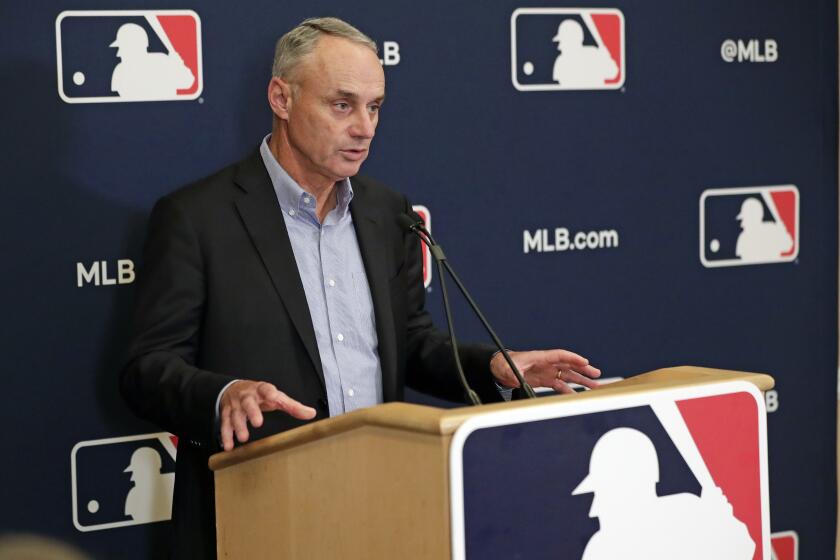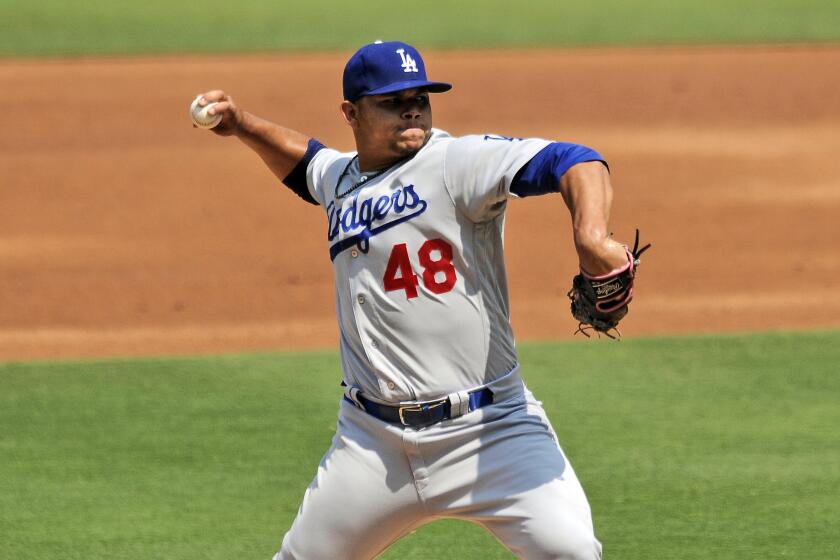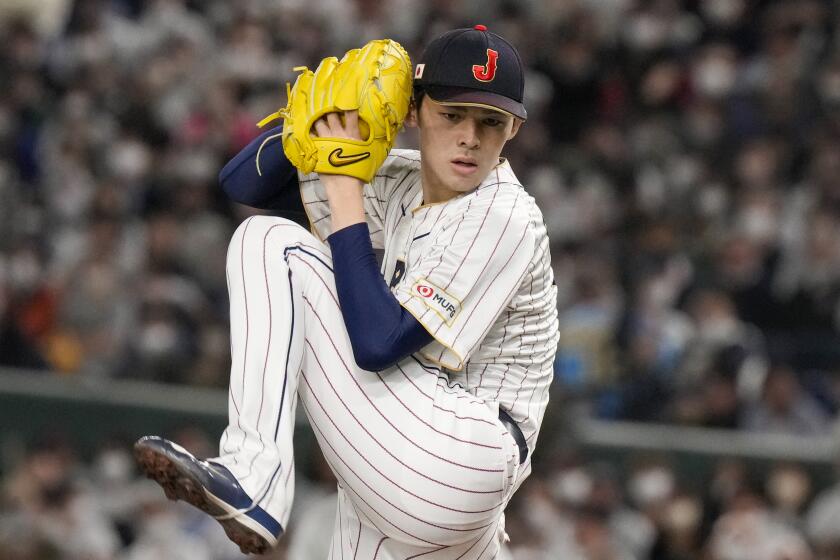It’s an alternate reality for these Dodgers working out every day at USC
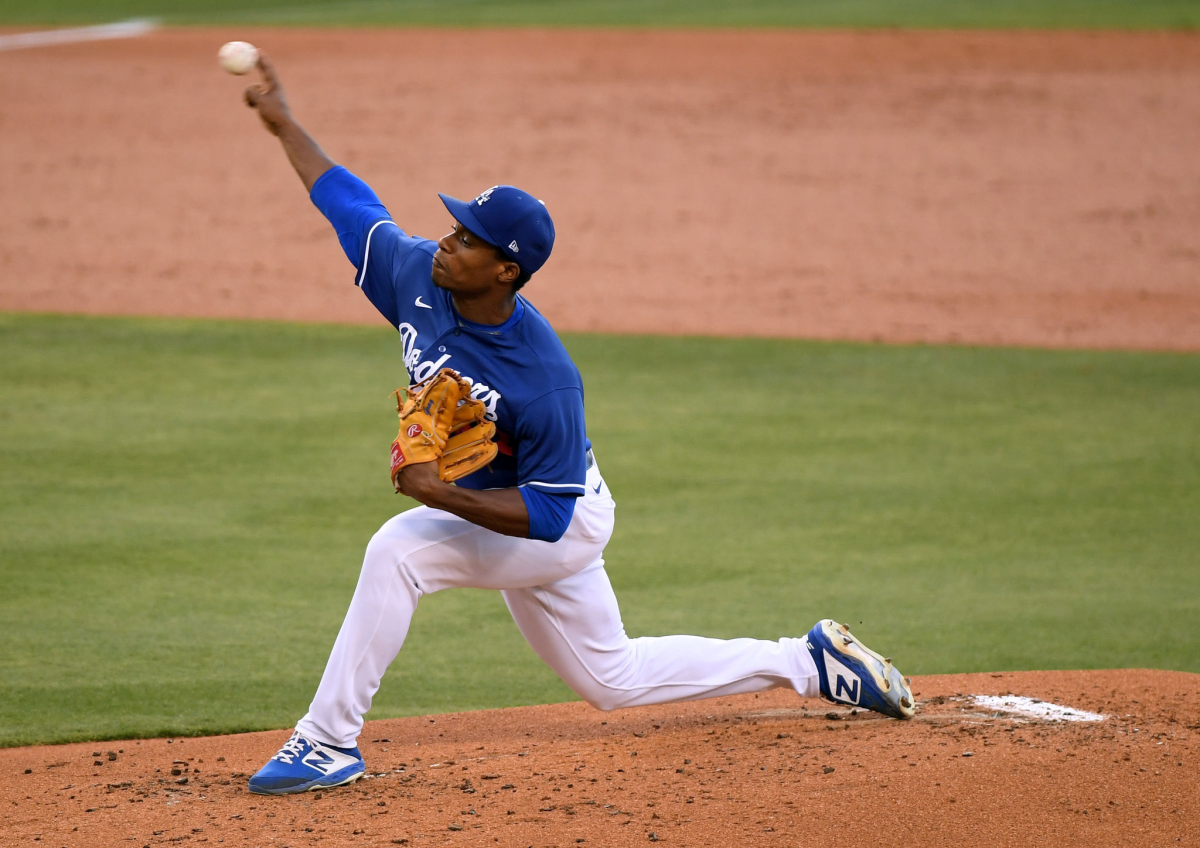
- Share via
Rocky Gale grabbed a spare chair from the dugout, placed it on a batting practice pitching ramp, and brought the Dodgers’ alternate site to a temporary halt.
For most of this summer, spirits have stayed high at the club’s USC-based training camp, where a collection of fringe big leaguers and top prospects have served as the organization’s only reserves during the pandemic-shortened season.
But on this recent afternoon, the veteran catcher sensed the group’s mood was starting to sag, that another day of isolated workouts and intrasquad scrimmages had driven his teammates to their wits’ end.
“All right,” Gale announced, directing their attention to his makeshift throne. “If anyone has any negative or salty thoughts, you’ve got to sit in this chair and just express them out. Let it out in this chair. After that, once you get off the chair, you’re fine. No more negativity.”
The so-called “salty chair” has remained in place since — a light-hearted yet ever-present reminder of the obstacles the Dodgers’ other team of 2020 has had to overcome.
Alternate sites were created specifically for this coronavirus-cautious campaign, with clubs sequestering 30-some substitute players at nearby college stadiums or minor league parks in case of injuries, ineffectiveness or an outbreak of infection on the big league roster.
With Mookie Betts and Chris Taylor out of the starting lineup, the Dodgers offense couldn’t muster enough offense to back starter Tony Gonsolin.
The back-up teams don’t play games against opponents and, aside from the handful of taxi squad players who accompany their MLB teams on the road, don’t leave their home markets. In the Dodgers’ case, most players have lived in a downtown hotel, from which they are bussed to daily practices at USC’s Dedeaux Field.
It’s an experience without parallel, a baseball version of Groundhog Day playing out in real life.
“You never know what you’re going to get with these situations,” said Shaun Larkin, an assistant field coordinator who has helped organize the Dodgers’ alternate site activities. “You’re basically on an island, going back and forth to the field only.”
When tasked with organizing the alternate site, Larkin and the rest of the staff didn’t know what to expect.
Their roster was an unusual mix of big league-caliber players waiting for a call-up, such as Tony Gonsolin and Gavin Lux (now both on the major league roster), and up-and-coming prospects such as infielder Kody Hoese and pitcher Josiah Gray trying to compensate for the canceled minor league season.
They structured practices like an instructional league or extended spring training, with morning field, batting cage and bullpen sessions followed by intrasquad scrimmages that rarely last nine innings because of a limited pitching staff.
“Each day is very similar,” said Travis Barbary, the Dodgers’ triple-A manager who has coached at the alternate site throughout the summer. “The hardest part is trying to replicate the same game-like intensity you would have during the regular season.”
To the coaches’ surprise, their players found a way.
“This group of guys, they feel like a team,” Larkin said. “They root for each other. There’s some nice trash talk, of course. But our guys get after it. There’s a sense of togetherness.”
MLB commissioner Rob Manfred considers an expanded playoff field a sign of progress and innovation, although plenty of others view it as a gimmick.
Small moments have created bonds. Barbary and other coaches occasionally catch bullpen sessions to give their catchers a break. The team learned to keep the home plate batting cage in place after foul balls kept landing in the middle of adjacent USC football workouts. During scrimmages, crowd noise and walk-up music are piped in through the stadium speakers.
“Things like that go a long way in programs like this,” Larkin said.
The site has paid important dividends for the club’s short-term and long-term fortunes too.
The MLB roster has received timely contributions from alternate site call-ups such as Gonsolin (now a likely member of the team’s playoff rotation), catcher Keibert Ruiz (who hit a home run in his MLB debut) and a rotating cast of arms in the bullpen.
Big leaguers have recovered from injuries at the camp, including starting pitcher Walker Buehler’s recent simulated-game outing after a finger blister put him on the injured list.
Perhaps most importantly, a future generation of players has avoided falling too far behind schedule in their development. Eleven of the club’s top 12 prospects, according to MLB Pipeline, have spent time at the site.
“That’s the most beneficial part about this, getting at-bats in,” said Hoese, 23, the 2019 first-round draft pick who was supposed to play his first full professional season this summer.
“Everything we’re doing here is so productive and so beneficial. Since we’re quarantined up and it’s the only thing we get to do all day, everyone goes about it with a really good, super positive attitude.”
The pitching situation for the Dodgers looks like elements for another postseason meltdown are in place, writes columnist Dylan Hernández.
The only regret is that the makeshift team won’t get the chance to play games against opponents, a competitive itch that controlled scrimmages in an empty college park have hardly scratched.
“There was a time, especially earlier, where our group of players really felt strongly they could beat a handful of other major league teams,” Larkin said.
Echoed Hoese: “Especially after watching some of these MLB games, we’ve seen some of these scores with 29 runs, like we can definitely do better than that. It’s a very competitive group that I think can compete right now.”
But as the alternate site nears its end — clubs will reportedly be allowed to continue operating the camps during the playoffs, but quarantine rules will likely prevent the reserve players from being involved in any postseason run — they’ve found satisfaction in other ways.
“What’s really made this whole thing go and be as productive as it has is just the quality of player that we have, the personalities,” Larkin said. “They’ve been fantastic. Anytime you have a unique situation like this, it’s the people that make you go [and] there’s been a lot of really cool things that have happened because of it.”
More to Read
Are you a true-blue fan?
Get our Dodgers Dugout newsletter for insights, news and much more.
You may occasionally receive promotional content from the Los Angeles Times.

